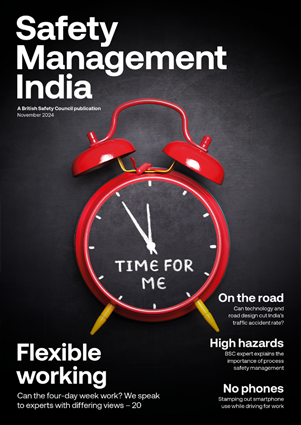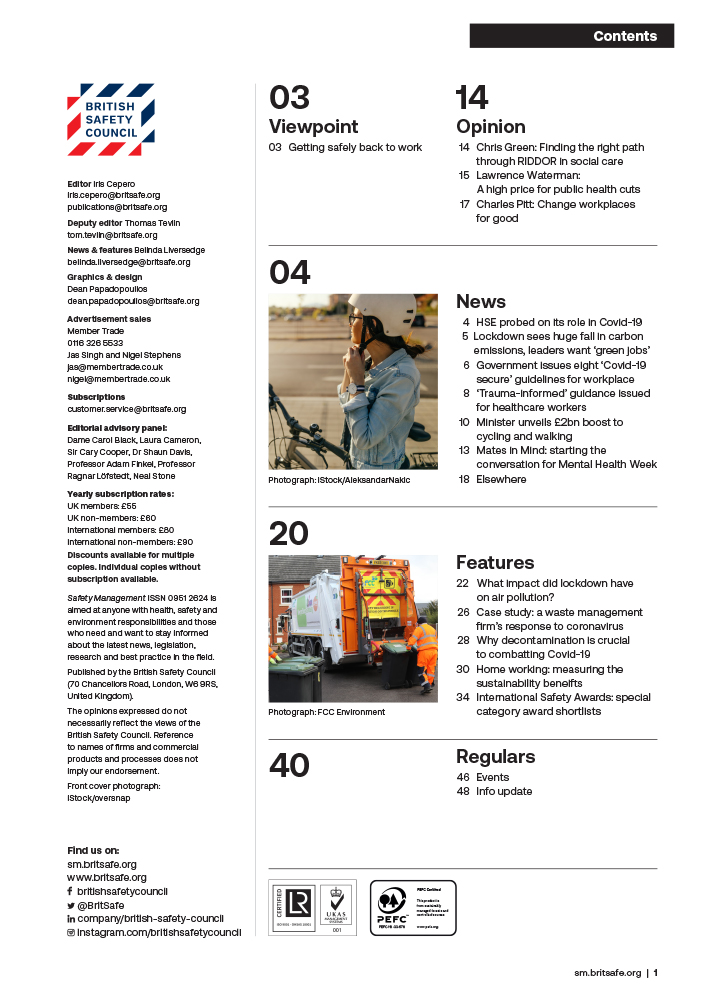With recent research once again highlighting the extent of asbestos in UK buildings, it is vital those in control of buildings like workplaces have effective plans and procedures in place to manage the risk to occupants.
Features
Asbestos essentials: getting it right
The Control of Asbestos Regulations (CAR) came into force in 2012, updating and replacing the previous 2006 law. They contain a wide range of requirements aimed at ensuring safe work with asbestos – such as around the prevention of exposure when working on asbestos-containing materials and safe removal procedures). They also contain duties on the notification of certain types of asbestos work to the enforcing authorities; designating (identifying) areas where work is being done on asbestos; medical surveillance for certain people who work with asbestos; record keeping; and ongoing safety awareness training for anyone who could be exposed to asbestos as a result of their work, such as asbestos removal contactors and tradespeople, like electricians, plumbers and cable installers.
 Photograph: iStock/shank_ali
Photograph: iStock/shank_ali
In November 2019, think tank ResPublica, produced their report Don’t Breathe In: Bridging the Asbestos Safety Gap, which set out key areas where the authors argue the UK’s asbestos risk management legislation has fallen behind our European counterparts.
This report prompted the all-party House of Commons Work and Pensions Select Committee (WPC) to launch an inquiry into HSE’s approach to asbestos management in the UK. The WPC subsequently issued a report in April 2022 outlining their findings and recommendations.
ATaC and NORAC review of UK asbestos management
More recently, during 2022, the Asbestos Testing and Consultancy Association (ATaC) and the National Organisation of Asbestos Consultants (NORAC), joined forces to collate and rationalise asbestos data that had been collected by their members between October 2021 and March 2022. Over one million lines of data were analysed and the resulting report, The First Annual Data Analysis Report Into Asbestos In UK Buildings, summarised their key findings about the current extent and condition of asbestos within UK buildings.
The ATaC/NORAC report outlined the following, which was put forward as evidence that the management of asbestos in the UK may require improvement:
- Of the 128,761 buildings inspected, 100,660 (78 per cent) were found to contain asbestos
- Within those 100,660 buildings, 710,433 items of asbestos were found
- Out of the 710,433 items of asbestos, 507,612 (71 per cent) were recorded as having some level of damage
- Of the 507,612 damaged items, 120,629 (24 per cent) would be classed as ‘licensable’ work and require a specialist contractor if they needed to be worked on, sealed or removed.
Although it is not yet clear if these recent and ongoing investigations, reports and lobbying will result in a change to the regulatory requirements around the UK’s approach to managing risks from asbestos in buildings, the government’s response to the WPC inquiry suggests this is probably unlikely in the short term.
However, there is an increasing weight of evidence to suggest that in some situations, a more proactive approach to asbestos management may be beneficial in reducing the risk of exposure further.
HSE’s second post-implementation review (PIR) of the Control of Asbestos Regulations 2012
The PIR report was originally due to be published by 6 April 2022 to meet statutory requirements. However, HSE delayed completion until February 2023, in order to consider the outcomes from the Work and Pensions Committee’s (WPC’s) inquiry into how HSE is managing the continued presence of asbestos in buildings.
The purpose of the PIR was to assess:
- The extent to which the regulations have achieved their objectives
- Whether the objectives remain appropriate, and
- If so, the extent to which they could be achieved with a system that imposes less regulation.
HSE published its first statutory PIR of CAR 2012 in March 2017.
The first PIR of CAR 2012 was an extensive review of the regulations. The second PIR built on the work of the first and took a proportionate approach to research. This avoided repetition, focusing on what has changed since the last PIR and what new developments have occurred in the industry.
Conclusion of PIR findings
Based on research supporting the PIR, including evidence from a stakeholder survey, cost-benefit analysis and epidemiological data, the 2023 PIR concluded that:
- The regulations are achieving their intended objectives and the objectives remain valid
- Intervention by regulation is still required and remains the most effective way to control the risks of exposure to asbestos
- It is not necessary to amend the provisions of CAR 2012 at this time.
The cost-benefit analysis concludes that the regulations have a net present value to society of £16.3 billion and the case for maintaining them remains strong. The assessment demonstrates that the benefits of CAR 2012 outweigh the costs and will continue to do so for the foreseeable future – as long as exposures continue to be controlled effectively.
HSE’s chief executive and chief scientific advisor gave oral evidence to the WPC in February 2022. The WPC asked how the committee’s work might contribute to HSE’s statutory review of the regulations, and what should be expected from the review. In response, HSE confirmed it would consider the WPC’s views and build them into the overall evidence base for the PIR.
 Matthew Harris is technical and quality director - asbestos at SOCOTEC. Photograph: SOCOTEC
Matthew Harris is technical and quality director - asbestos at SOCOTEC. Photograph: SOCOTEC
Stakeholder responses to the PIR responses were broadly supportive of the regulations, and consequently, HSE was not proposing to make changes to them, HSE told the WPC.
The full Second PIR of the Control of Asbestos Regulations 2012 S.I. 2012/632 can be found here.
Retained EU Law (Revocation and Reform) Bill
Despite the above outlined findings, CAR 2012 is one of many UK sets of regulations tabled to automatically be repealed on 31 December 2023, under the Retained EU Law (Revocation and Reform) Bill, unless action is taken by ministers prior to this date. At the time of writing, the Bill has passed through Parliament and is currently sitting with the House of Lords awaiting the third reading, before passing for Royal Assent.
The Bill applies to 58 health and safety-related regulations, along with all other EU-retained laws, and seeks to automatically repeal them on 31 December 2023, unless ministers take action to reprieve them.
The Bill does provide an option to delay the repeal, which is limited until June 2026, or ministers can seek to replace the regulations with new ones. The replacement regulations are permitted to be changed to become less burdensome (i.e. offer less protections) but they cannot become more burdensome.
With limited time remaining prior to the automatic repeal, it would seem highly unlikely that all 58 regulations will be rewritten, particularly as this process is not yet under way.
Intensive lobbying is underway to obtain information from the government over their plans for these regulations. Most notably, seven leading health and safety bodies and associations have written an open letter to the government, calling for the arbitrary deadlines of the EU Retained Law Bill to be scrapped and for ministers to ensure there is a full consultative process so vital health and safety laws are protected.
Use of asbestos
Although the importation, supply and use of asbestos was banned back in 1999, the UK continues to experience challenges when it comes to managing asbestos within buildings. Asbestos is the single largest cause of work-related fatalities in the UK, and the presence of asbestos continues to pose a threat to the general public, with an average of 5,500 people a year dying of asbestos-related diseases.
Despite the nationwide ban in 1999, vast quantities of asbestos remain present inside public and private buildings. Six million tonnes of raw asbestos were imported into the UK, which translates to many more millions of tonnes of asbestos products when taking into account the fact that it is mixed with other materials. For example, asbestos cement typically has an asbestos content of 15–40 per cent. It is estimated that asbestos-containing materials (ACMs) can be found more than 1.5 million UK buildings, including public spaces, such as hospitals and schools.
The individuals and organisations in charge of non-domestic buildings in the UK have legal responsibilities under CAR 2012 to prevent and reduce the health risks posed by ACMs. Current UK policy states that if asbestos is in a good condition and unlikely to be disturbed, then it is not considered a significant health risk, as long as it remains properly managed.
Responsibilities for asbestos management in the UK
The Health and Safety at Work Act 1974 and Management of Health and Safety at Work Regulations 1999 place a general legal duty on employers to prevent exposure to and assess the risks posed by asbestos. HSE has estimated that asbestos may still be present in 300,000 non-domestic buildings and many more homes, despite long-term efforts to remove it.
More specifically, CAR 2012 requires the dutyholder responsible for the maintenance and repair of non-domestic premises where asbestos may be present to manage any asbestos in the building so that people who work in the premises or use them – such as the building’s employees, occupants and visiting tradespeople – are protected from exposure. Dutyholders must:
- Take reasonable steps to find out if there are materials containing asbestos in non-domestic premises, and if so, its amount, where it is and what condition it is in
- Make, and keep up-to-date, a record of the location and condition of the ACMs – or materials which are presumed to contain asbestos
- Assess the risk of anyone being exposed to fibres from the materials identified
- Prepare a long-term plan and strategy that sets out in detail how the risks from these materials will be managed
- Prevent work on the premises that may disturb the fabric of the building until measures to control the risks have been implemented
- Provide information on the location and condition of the materials and the plan for managing them to anyone who is liable to work on or disturb them, so they can put in place appropriate controls to prevent people being exposed
- Regularly monitor and review the management plan to ensure it remains relevant and up-to-date.
Duty to manage asbestos
Under CAR 2012, the primary responsibility to manage the risks from asbestos in non-domestic buildings lies with the dutyholder. This is defined as the person or organisation responsible for the maintenance and/or repair of the building, such as the owner, employer or managing agent. The dutyholder has a legal duty to ensure the safe management of any ACMs that are present in their building, and is also liable for prosecution if the regulations are breached.
In order to manage the presence of asbestos in buildings, dutyholders are expected to survey their building to identify any ACMs or suspected ACMs; create a register of ACMs; and draw up and implement a written asbestos management plan setting out the procedures that will be followed to properly monitor the condition of the ACMs in case they become damaged or deteriorate.
The asbestos management plan is a vital document which records and sets out the ways asbestos will be managed across a particular property, and how people using the site will be kept safe from exposure to the fibrous mineral. It should be clear, simple and easily accessible, and dutyholders will need to ensure that it is reviewed regularly.
Matthew Harris is technical and quality director – asbestos at SOCOTEC.
For more information see:


FEATURES
Why changes to recycling legislation in England are an opportunity, not a burden
By on 12 November 2024

Road safety in India: could better road safety, vehicle technology and enforcement make driving for work safer?
By Orchie Bandyopadhyay on 10 November 2024
India has a poor road safety record, and research shows that commercial vehicles are a major contributor to the problem, with trucks estimated to be the single largest vehicle type involved in impacts leading to fatalities. We look at solutions that could make driving for work and the roads in general safer – from in-vehicle technology that warns truck drivers about unsafe behaviour to improving the design features of major highways.

